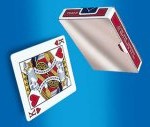*Canasta* |



![]()
![]()
![]()
*Introduction to the Canasta Game:
The game of Canasta is said to have originated in Montivideo, Uruguay, around 1940. From there it spread to Argentina, the USA and throughout the world. It was extremely fashionable in the 1950's, threatening for a while to displace Contract Bridge as the premier card game.
Canasta is generally agreed to be best for four players, playing in partnerships. However, there are playable versions for two and three players also.
The Cards -
Canasta is normally played with two standard 52 card packs plus four jokers (two from each pack), making 108 cards in all, each is marked with their own standard point values.
The Deal and Play
Each player is dealt a hand of cards, and in the centre of the table is a face-down pile of cards called the stock and a face-up pile of cards called the discard pile. The player to the left of the dealer plays first, and then the turn to play passes clockwise. A basic turn consists of drawing the top card of the stock, adding it to your hand without showing it to the other players, and discarding one card from your hand face up on top of the discard pile.
The play ends when a player goes out, i.e. disposes of all the cards in his or her hand. Having achieved this, you can go out by melding all but one of the cards in your hand and discarding this last card.
Melds and Canastas
The object of the game is to score points by melding cards. A valid meld consists of three or more cards of the same natural rank (any rank from four up to ace), such as three kings, six fives, etc.
A meld of seven cards is called a canasta. In some versions of Canasta you may create a meld of more than seven cards, simply by continuing to add more cards of the same rank to an already complete canasta.
* Excerpt from: Canasta-Introduction by permission of Mr. John McLeod, author. For more information on this simple and fun game, see : http://www.pagat.com/rummy/canasta.html